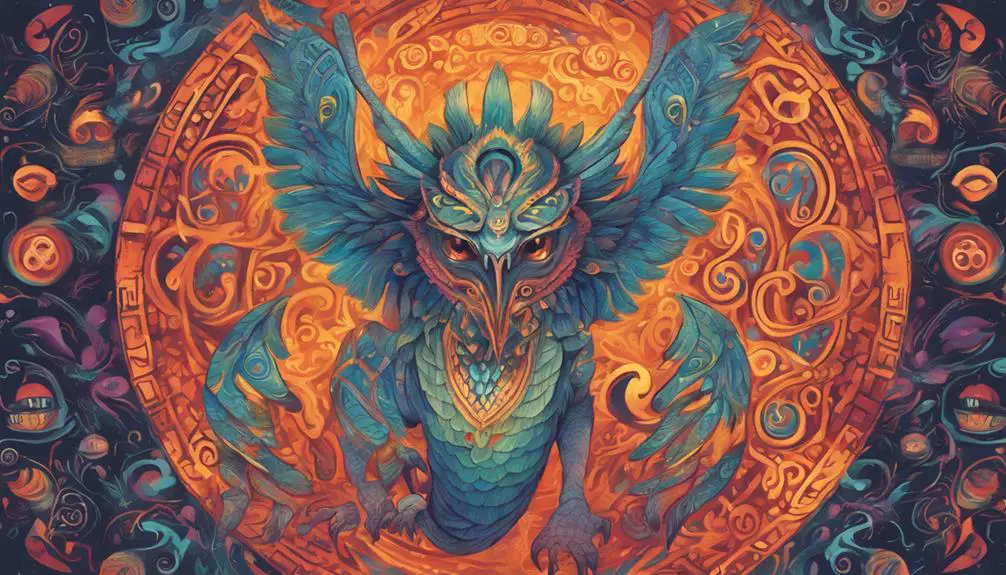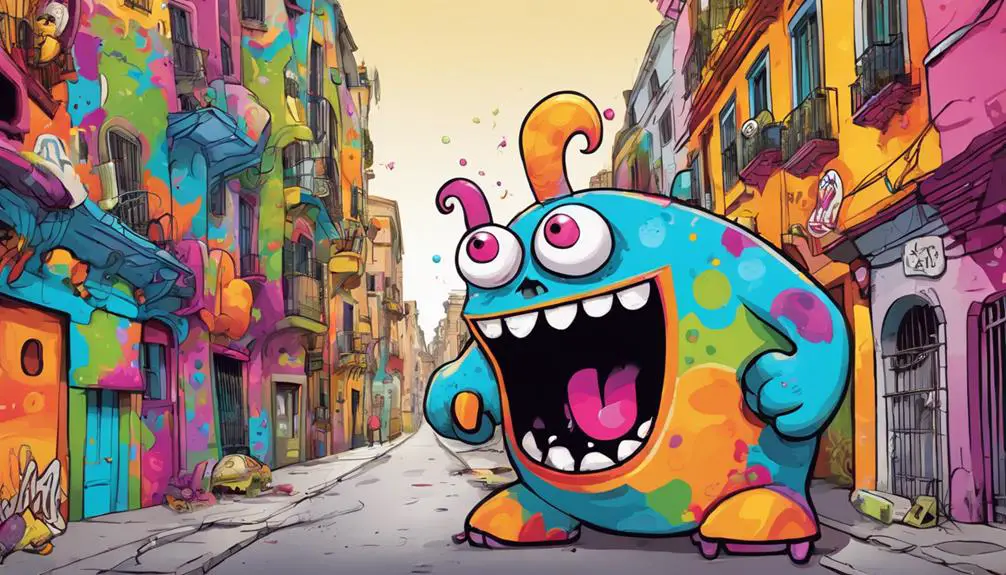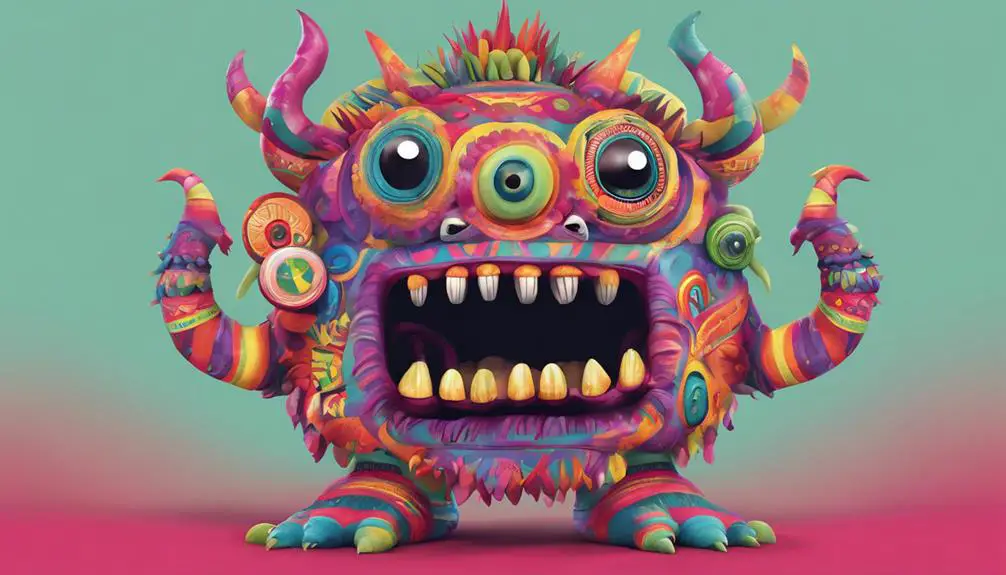When you hear 'monstruo' in Latin American slang, you're likely encountering a term of endearment that's evolved from its European roots to become an integral part of everyday conversations and social media culture. You'll find it used to convey admiration, praise, and even playfulness, often in humorous contexts. As you explore its cultural significance, you'll discover a complex symbol with deep roots in folklore and mythology, reflecting societal concerns and tensions between influences. As you uncover more, you'll find that 'monstruo' holds a unique charm, showcasing the versatility and adaptability of language in Latin American culture.
Origins of Monstruo in Latin America

As you explore the nuances of Spanish slang, you'll discover the fascinating origins of the term 'monstruo' in Latin America. Derived from the Latin 'monstrum,' meaning omen or portent, the term 'monstruo' emerged in Latin America as a slang expression, carrying connotations of something extraordinary, remarkable, or even fearsome.
This linguistic evolution is deeply rooted in the region's colonial past. During the colonial era, Latin American languages were heavily influenced by their European colonizers, particularly the Spanish and Portuguese. The Latin roots of 'monstruo' were adopted and adapted, taking on new meanings and connotations in the Americas. The term's transformation was likely shaped by the cultural exchange and blending of indigenous, African, and European influences.
As a result, 'monstruo' became a unique expression, distinct from its Latin roots. You'll notice that this slang term is now deeply ingrained in Latin American popular culture, reflecting the region's complex history and cultural diversity.
Expressing Admiration With Monstruo
One striking feature of the slang term 'monstruo' is its importance to convey admiration and awe when used to describe someone or something that impresses you.
When you say 'Ese tipo es un monstruo en el fútbol' (That guy is a monster on the soccer field), you're not implying that he's scary or intimidating, but rather that he's exceptionally skilled. On this occasion, 'monstruo' serves as an admiration intensifier, amplifying your praise and conveying a sense of astonishment.
This usage of 'monstruo' has become a cultural phenomenon in many Spanish-speaking countries, where it's common to hear people exclaim '¡Eres un monstruo!' (You're a monster!) to express admiration for someone's talent or achievement.
By using 'monstruo' in this manner, you're able to convey a strong sense of admiration and respect, making it a powerful tool in your linguistic arsenal.
As you navigate the nuances of Spanish slang, understanding the versatility of 'monstruo' and its ability to convey a range of emotions, from admiration to astonishment, is crucial.
Monster in Latin American Culture

In Latin American culture, the concept of 'monstruo' extends beyond its colloquial usage to represent a complex symbol with deep roots in folklore, mythology, and social commentary. As you explore the cultural significance of 'monstruo', you'll discover that it embodies the complexities of Latin American identity.
In Latin folklore, monsters and supernatural creatures are often depicted as manifestations of cultural anxieties, fears, and desires. The 'monstruo' symbol serves as a reflection of societal concerns, such as the struggle between tradition and modernity, the impact of colonialism, and the blurring of cultural boundaries.
You'll find that the 'monstruo' isn't just a mythical creature, but a cultural icon that encapsulates the complexities of Latin American cultural identity. It represents the tension between indigenous and European influences, as well as the African diasporic experience.
Through the lens of 'monstruo', you can gain a deeper understanding of the region's rich cultural heritage and the ways in which folklore and mythology continue to shape cultural identity. As you investigate the cultural significance of 'monstruo', you'll uncover a rich tapestry of meanings and interpretations that reflect the complexities of Latin American culture.
Social Media and Monstruo Meme
On social media platforms, you're likely to stumble upon the 'monstruo meme,' a humorous representation of the Latin American cultural icon that has taken on a life of its own, often poking fun at societal norms and cultural expectations. This meme's popularity can be attributed to its relatability, as it cleverly captures the essence of Latin American culture.
As online trends go, the 'monstruo meme' has become a staple in many social media feeds, with users creating and sharing their own variations.
The meme's success can be attributed to its versatility, allowing users to adapt it to various contexts, from poking fun at everyday struggles to commenting on social issues. Its widespread appeal lies in its ability to transcend cultural boundaries, resonating with audiences from diverse backgrounds.
As a result, the 'monstruo meme' has become a cultural phenomenon, reflecting the power of social media in shaping online trends and popular culture. By examining the meme's popularity, we gain insight into the ways in which social media platforms facilitate the dissemination of cultural icons and their subsequent transformation into relatable, humorous representations.
Monstruo in Everyday Conversations

Beyond the digital domain, the term 'monstruo' has permeated everyday conversations in Latin American culture, where you'll often hear it used to humorously describe a friend or family member who's being particularly demanding or exhausting.
You might say, 'Eres un monstruo' (You're a monster) to a friend who's being overly dramatic or clingy. This phrase is often used in a lighthearted manner, implying that the person is being a bit too much to handle.
In everyday conversations, 'monstruo' idioms are commonly used to poke fun at someone's behavior or attitude. For instance, 'Hacerse el monstruo' (to play the monster) means to pretend to be offended or upset, usually to get attention. These idioms have become an integral part of everyday insults in Latin American culture, allowing individuals to express themselves in a humorous and playful way.
Monstruo as a Term of Endearment
You'll often hear 'monstruo' used affectionately within Latin American culture, particularly among close friends or family members, where it takes on a surprisingly tender connotation. This term, which translates to 'monster' in English, is often employed to express affection and fondness towards someone.
When utilized in this situation, 'monstruo' is stripped of its frightening implications, and instead, it embodies a sense of playfulness and endearment. You might hear someone say, 'Mi monstruo' (my monster), implying a deep affection and closeness. This term of endearment is often accompanied by affectionate phrases, such as 'Mi querido monstruo' (my lovely monster) or 'Mi dulce bestia' (my sweet beast).
The phrase 'Lovely Brute' is another common translation, which highlights the contrast between the intimidating connotations of 'monster' and the loving intent behind its usage. This peculiar term of endearment showcases the creativity and expressiveness of Latin American culture, where even the most unlikely words can take on a new, affectionate meaning.
Monstruo in Different Latin Countries

While the endearing connotation of 'monstruo' is widespread across Latin America, its usage and nuances vary greatly from country to country, reflecting distinct cultural identities and linguistic traditions.
As you explore the regional variations of 'monstruo', you'll notice that in Mexico, it's often used to express affection, similar to 'honey' or 'sweetheart'.
In Argentina, however, 'monstruo' takes on a more playful tone, implying a mischievous or quirky personality.
In Colombia, the term is used to describe someone who's exceptionally skilled or talented, often in a humorous way.
These cultural differences are rooted in the unique historical, social, and linguistic contexts of each country.
For instance, Mexico's indigenous heritage has influenced the use of 'monstruo' as a term of endearment, whereas Argentina's Italian and Spanish immigrant history has shaped its usage in a more playful context.
Understanding these regional variations can provide valuable insights into the complexities of Latin American cultures and their diverse linguistic traditions.
Monstruo Vs. Traditional Spanish Words
When comparing the informal, affectionate connotations of 'monstruo' to traditional Spanish words like 'querido' or 'amigo,' it becomes clear that the former has carved out a unique niche in Latin American slang.
You may wonder, what sets 'monstruo' apart from its more formal equivalents? The answer lies in its colloquial, regional flavor.
Unlike 'querido' or 'amigo,' which are universally understood and accepted across different regional dialects, 'monstruo' is deeply rooted in specific Latin American cultures. This regional specificity is what gives 'monstruo' its unique charm and allows it to convey a sense of familiarity and closeness.
Furthermore, 'monstruo' doesn't carry the same level of formality as traditional words, making it more approachable and casual in tone.
As you explore the nuances of Latin American slang, you'll find that 'monstruo' occupies a distinct space, one that blends affection with a touch of playfulness.
Monstruo and Its English Counterparts

As you venture into the world of English slang, you'll likely find that 'monstruo' has several counterparts that convey a similar tone of affection and playfulness.
One such counterpart is the term 'beast,' which, like 'monstruo,' is often used to affectionately describe someone who excels in a particular activity or has exceptional skills.
Another cultural equivalent is the term 'monster,' which, in some contexts, can carry a similar tone of admiration and respect.
When examining monstrous translations, it's essential to consider the cultural context in which they're used.
For instance, while 'beast' and 'monster' may be used in casual, informal settings, they can also be employed in more formal contexts, such as sports or academic achievements.
This flexibility in usage is reminiscent of 'monstruo,' which, as we've seen, can be used in various contexts to convey a range of emotions and attitudes.
In exploring these cultural equivalents, it becomes clear that the concept of 'monstruo' isn't unique to Spanish slang.
Rather, it reflects a broader cultural trend of using terms with monstrous connotations to express admiration and respect.
Monstruo's Evolution in Modern Spanish
In modern Spanish, you'll find that the term 'monstruo' has undergone significant semantic shifts, expanding its original connotation of fear to encompass a broader range of emotions and attitudes. This metamorphosis has led to a more nuanced understanding of the concept, allowing it to adapt to various contexts and connotations.
In contemporary Spanish colloquialism, 'monstruo' can convey a sense of admiration or awe, as in 'Eres un monstruo en el fútbol' (You're a monster on the soccer field), implying exceptional skill or prowess. This shift in meaning highlights the term's versatility and ability to evolve with linguistic and cultural trends.
Monstruo's evolution also reflects changes in societal values and norms. For instance, the term is often used to describe someone who excels in a particular field or activity, such as 'Es un monstruo de la cocina' (He's a monster in the kitchen), emphasizing exceptional talent or skill.
As you explore the complexities of modern Spanish, it becomes clear that 'monstruo' has transcended its original meaning, embracing a more multifaceted character. This adaptability underscores the dynamic nature of language, where words and meanings evolve to reflect the changing needs and attitudes of its speakers.
Frequently Asked Questions
Is Monstruo Used in Formal Writing or Professional Settings?
When you're writing in a formal tone for professional contexts, you might wonder if certain words are suitable. In this case, you're asking about 'monstruo'.
Generally, in formal writing, you'll want to opt for more formal vocabulary. While 'monstruo' isn't inherently informal, it may not be the best choice for a professional context.
You might consider alternative terms that convey a more formal tone, ensuring your writing is precise and professional.
Can Monstruo Be Used to Describe an Inanimate Object?
When you're 'beating around the bush' trying to describe an inanimate object, you might wonder if you can label it a 'monstruo'. Essentially, can you use object personification to give an object monstrous qualities?
The answer lies in figurative language. While it's possible to use 'monstruo' to describe an object, it would be an unconventional choice, even in creative writing.
In academic or formal contexts, it's best to stick with literal descriptions to maintain clarity and precision.
Is Monstruo Only Used to Describe Someone's Physical Appearance?
When you examine the term 'monstruo,' you might assume it's solely used to describe someone's physical appearance. However, that's not entirely accurate.
While it's true that facial features and body language can contribute to someone being labeled a 'monstruo,' the term encompasses more than just physical traits.
In reality, it can also imply unusual or intimidating behavior, making it a more complex descriptor than you might've initially thought.
Can Monstruo Be Used in a Derogatory or Offensive Manner?
Imagine a thousand daggers piercing your reputation – that's the weight of a derogatory term.
When it comes to utilizing 'monstruo' in a derogatory or offensive manner, you need to take into account the cultural implications and social connotations.
In some Latin American countries, 'monstruo' can be used to belittle someone's character, implying they're a monster in behavior, not just appearance.
You must be mindful of the nuances, as using it offensively can lead to damaging relationships and sparking controversy.
Is Monstruo Commonly Used in All Latin American Countries?
When exploring linguistic variations across Latin America, you'll find that regional differences play a crucial role.
You'll notice that dialect differences greatly impact the usage of certain words, including 'monstruo'.
While it's widely understood, its frequency and connotation vary greatly across countries.
You'll discover that some nations, like Argentina and Uruguay, employ it more frequently, whereas others, like Mexico, use it less often.
Regional variations and dialect differences shape the word's usage, making it vital to take these factors into account when communicating across Latin American cultures.
Conclusion
As you've explored the world of 'monstruo' in Latin American slang, you've uncovered a linguistic phenomenon that's both fascinating and bewildering.
This monster of a word has taken on a life of its own, morphing from a literal translation to a cultural icon. With its evolution, 'monstruo' has become a reflection of the region's vibrant identity, a proof of the power of language to shape and be shaped by culture.
So, the next time you call something 'monstruo,' remember, you're not just expressing admiration – you're tapping into a rich cultural heritage.







